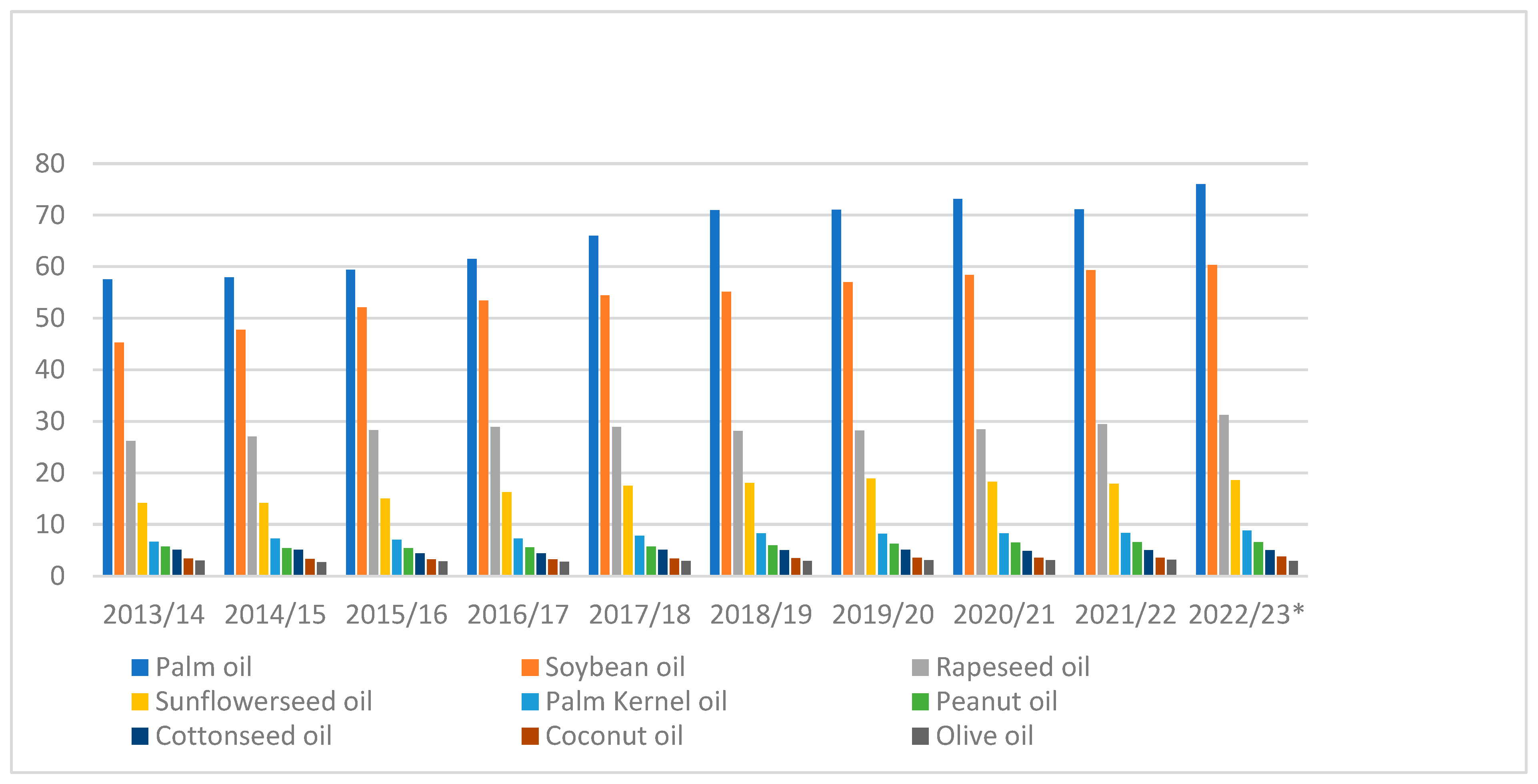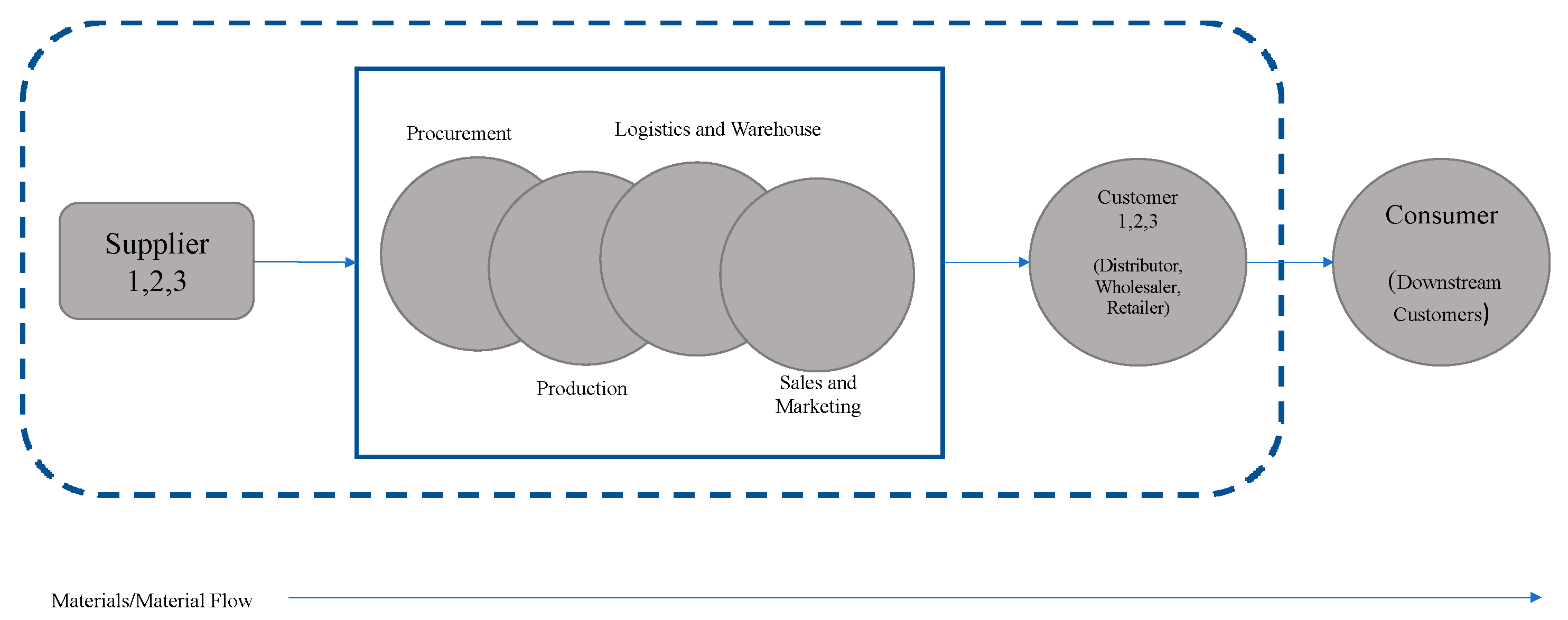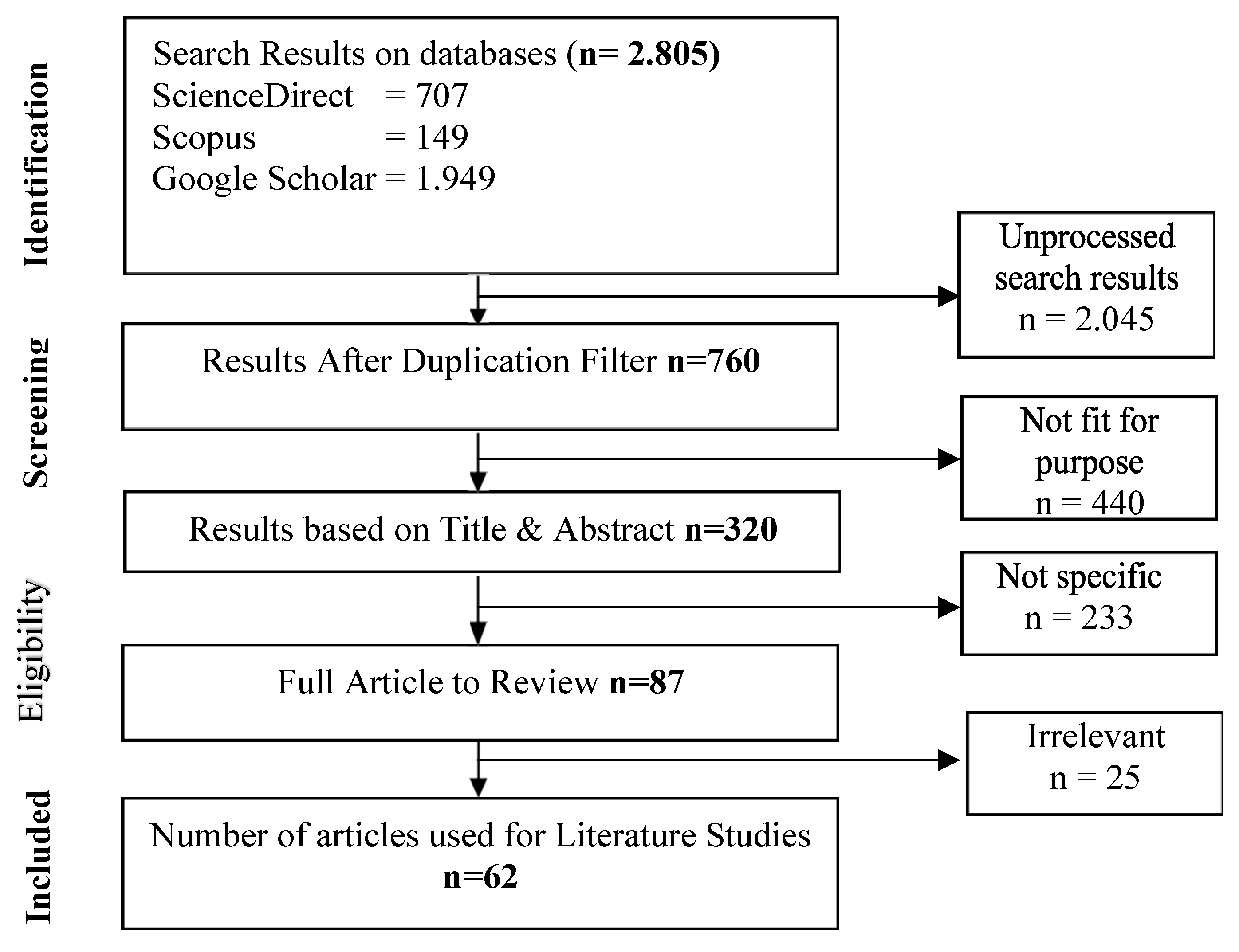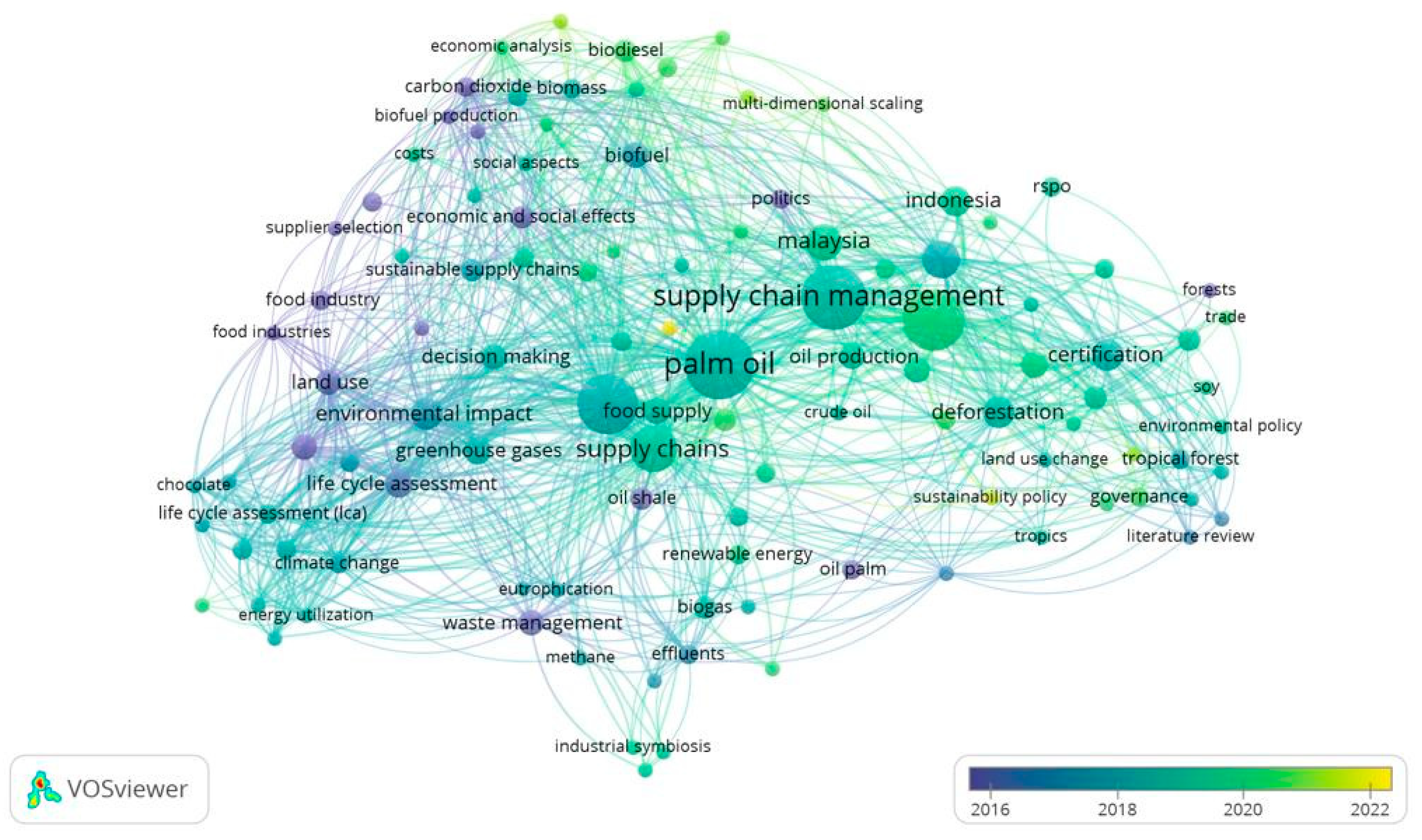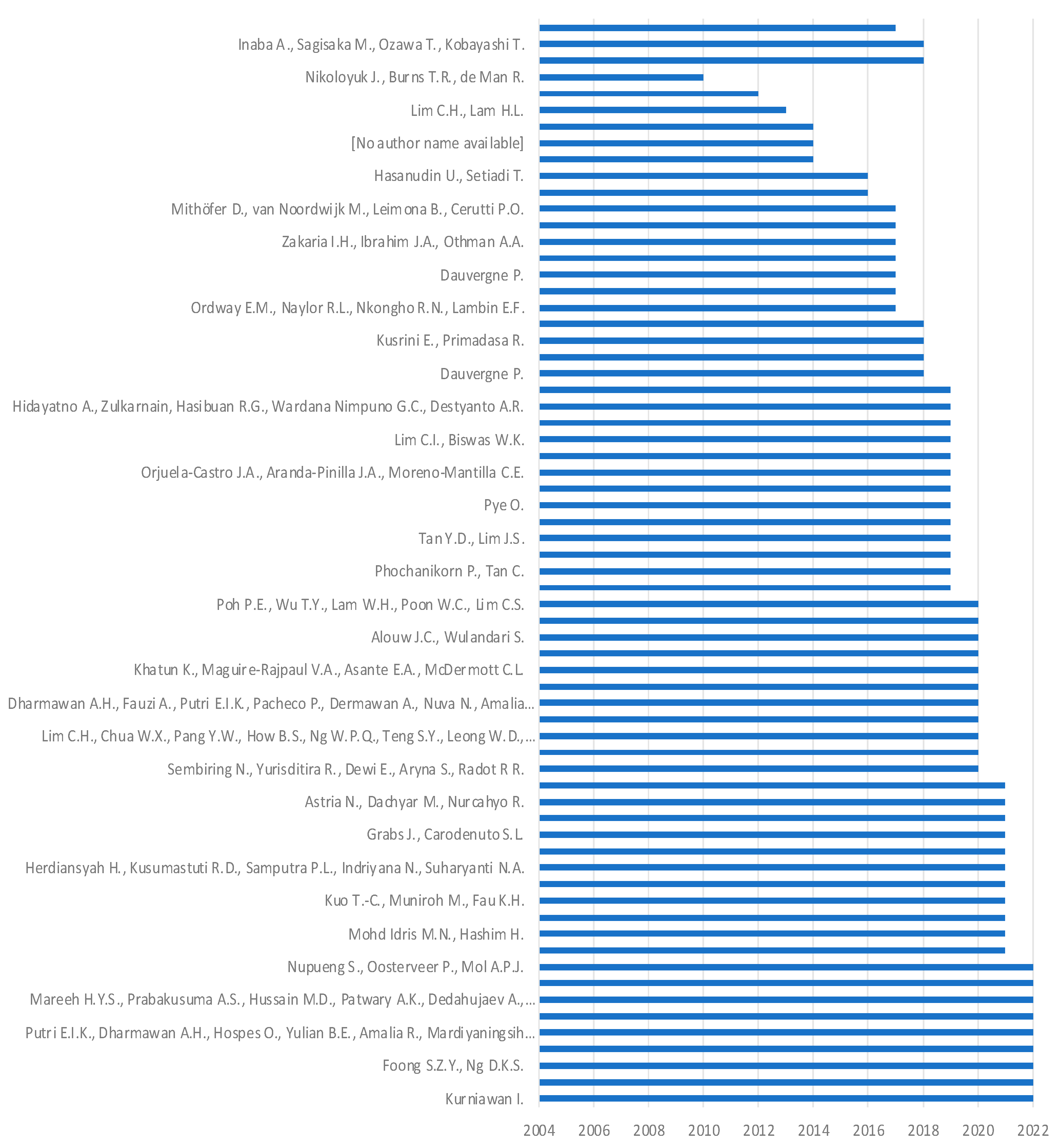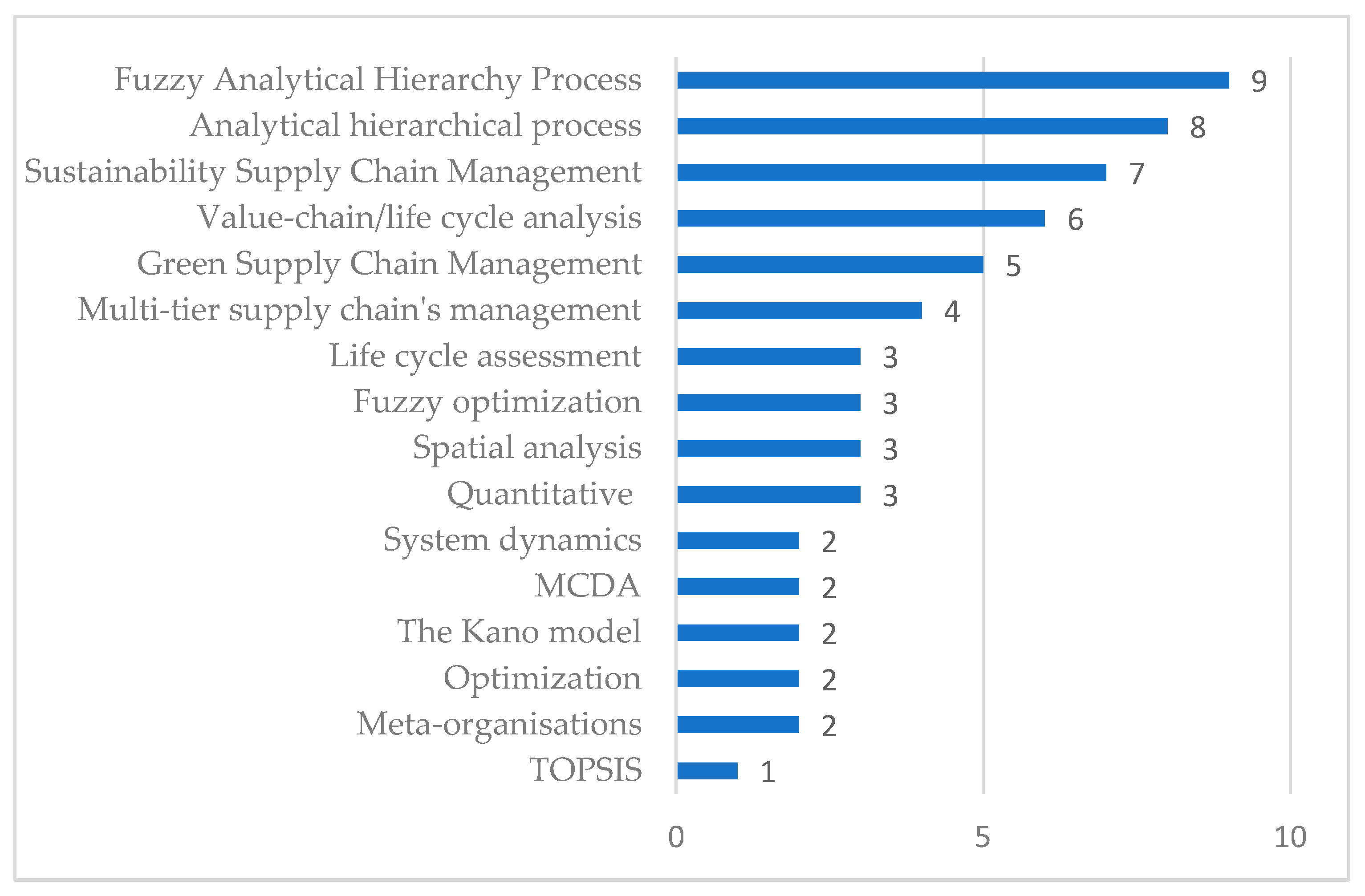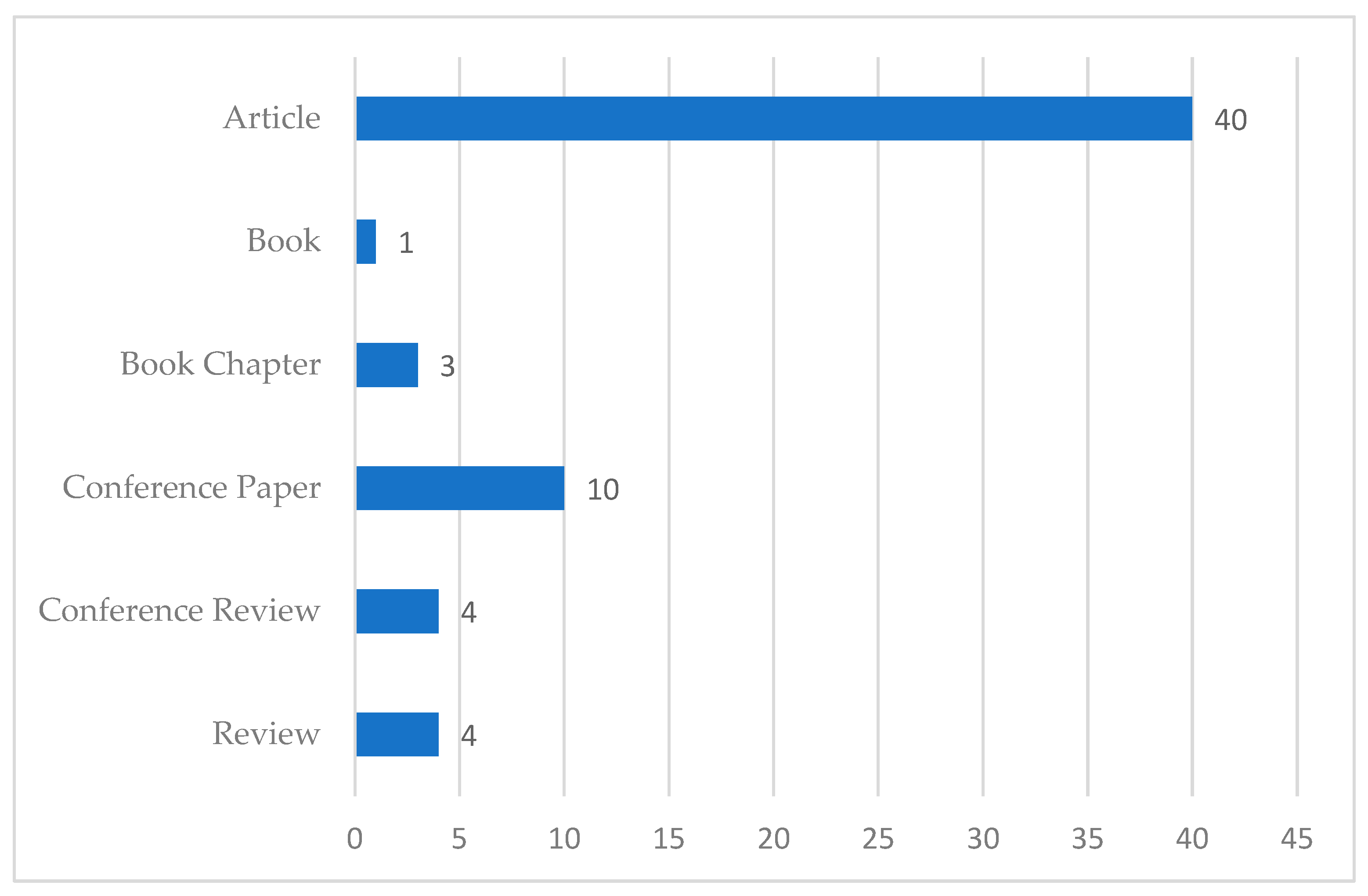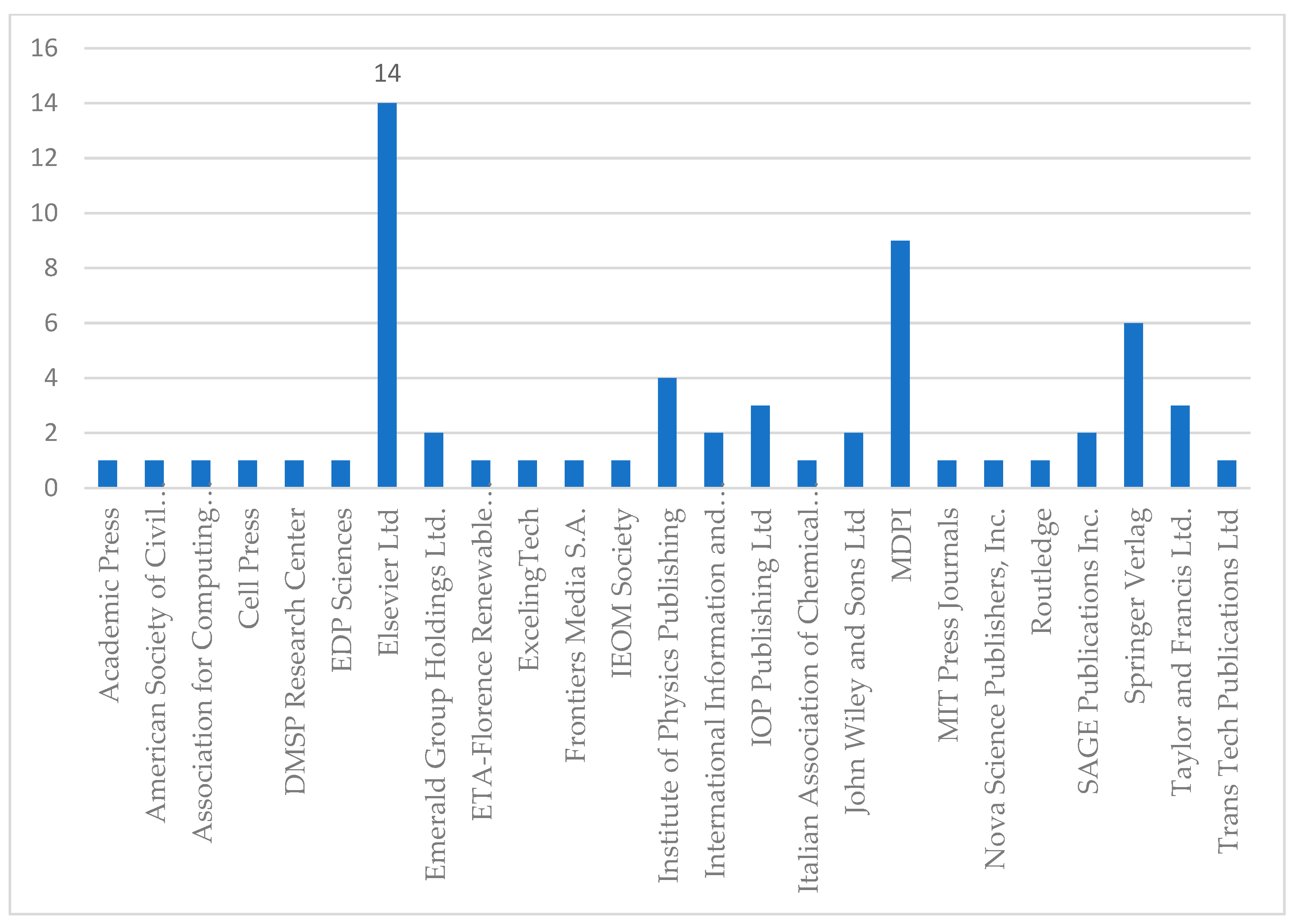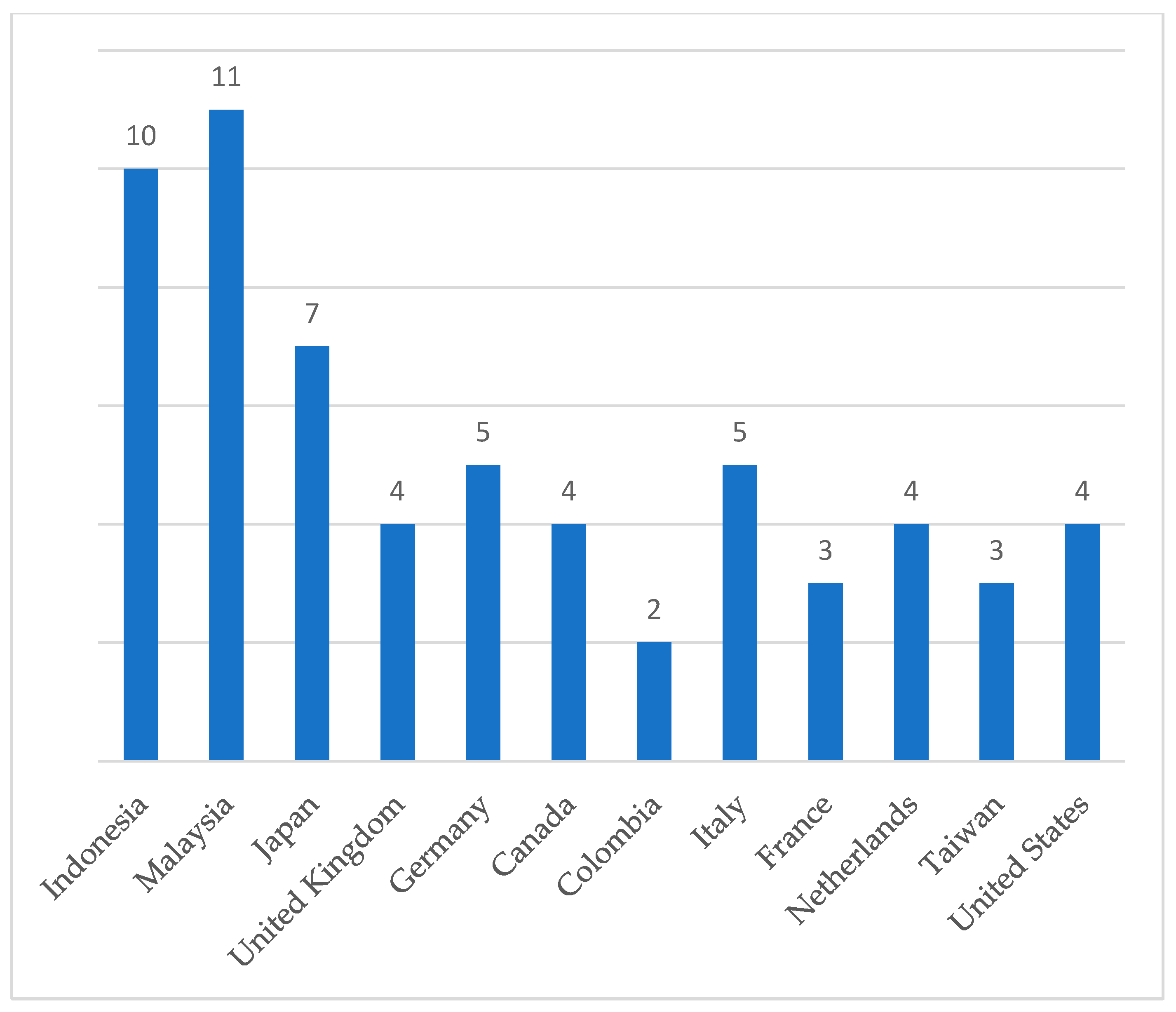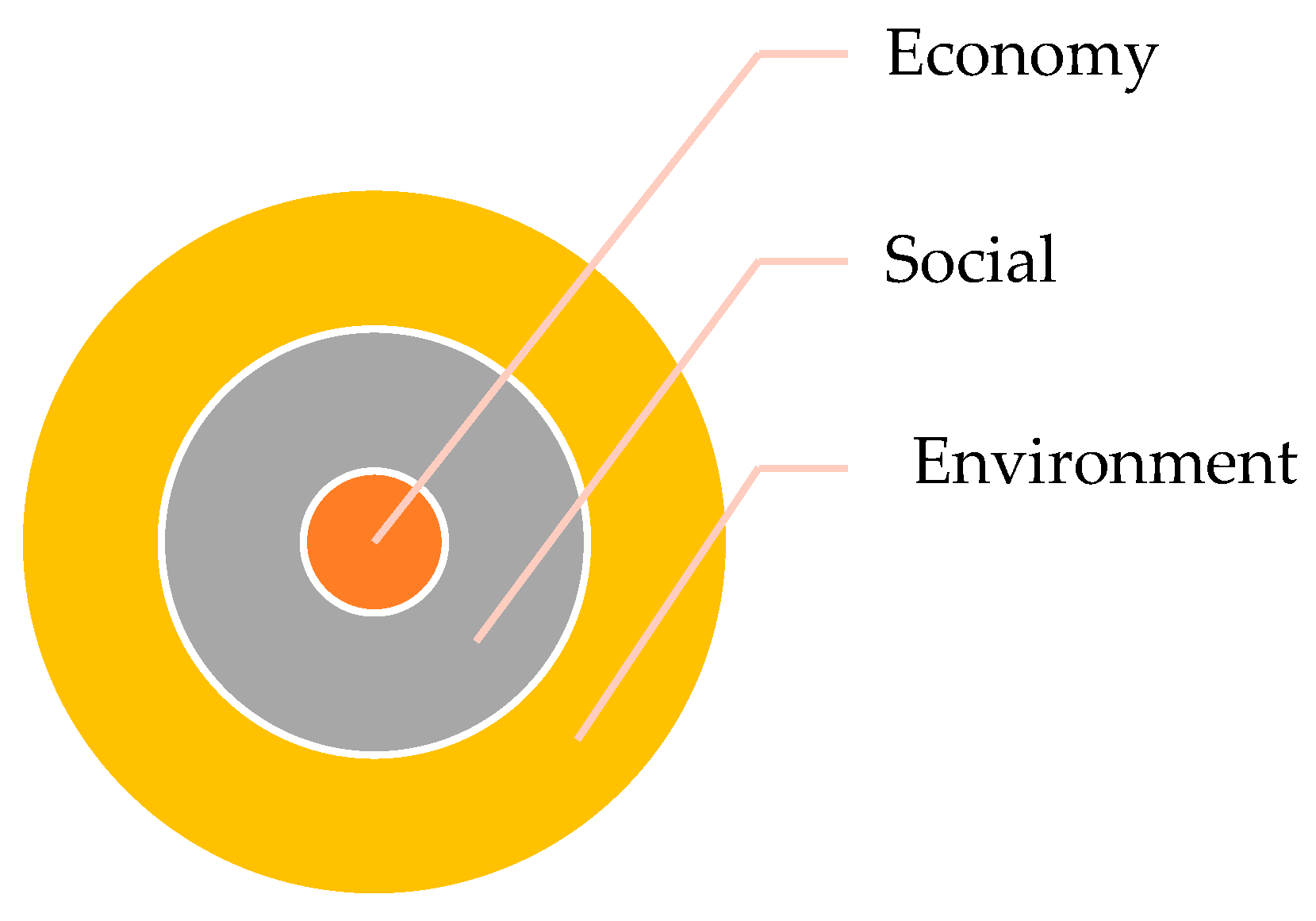1. Introduction
Palm oil is one of the most widely used vegetable oils and has many applications in food, cosmetics, and other consumer products. Palm oil is one of the most widely used vegetable oils in the world. In 2022, global palm oil production will reach 76.5 million metric tons, accounting for approximately 36% of total vegetable oil production [
1]. Palm oil is used in various food and non-food products including cooking oil, margarine, chocolate, baked goods, cosmetics, and biofuels [
2]. The top palm oil producers are Indonesia and Malaysia, which account for approximately 85% of global palm oil production [
3]. Other countries that produce significant amounts of palm oil include Thailand, Colombia, and Nigeria [
1]. The demand for palm oil is expected to grow because of its versatility and relatively low cost compared with other vegetable oils (
Figure 1) it is still a data estimation (*) numbers that are still being forecasted in 2023, which means that the organization has not yet made them public. However, the environmental and social impacts of palm oil production have led to increased scrutiny and efforts to promote sustainable palm oil production.
Moreover, the rapid expansion of palm oil production has brought about significant environmental and social impacts, including deforestation, habitat destruction, and human rights abuse. In recent years, there has been growing global concern regarding palm oil production and sustainable supply chains [
4]. Governments, NGOs, and industry stakeholders have addressed these concerns through sustainable palm oil certification schemes, voluntary commitments, and other initiatives. However, there is still much debate surrounding the effectiveness and impact of these efforts.
Sustainable supply chain management (SSCM) is a critical aspect of modern business operations, and its implementation has become increasingly important to ensure that companies meet their sustainable supply chain goals. In recent years, there has been growing concern regarding the environmental and social impacts of palm oil production, prompting researchers to conduct systematic literature reviews (SLRs) on the SSCM performance of palm oil products.
To better understand the state of knowledge on the sustainable and supply chain management of palm oil, researchers have conducted SLRs. SLRs are research methods that synthesize and analyze the existing literature on a specific topic. They provide a comprehensive and structured overview of the available evidence and help to identify gaps and opportunities for future research. One example of an SLR on sustainable palm oil and supply chain management was a study by [
5]. The authors comprehensively reviewed the literature on sustainable palm oil production and supply chains, focusing on the sustainable environmental, social, and economic issues. They analyzed 140 articles published between 2004 and 2018, using a systematic approach to identify key themes and trends in the literature, different from our paper, which analyzes articles from 2014–2021 on the performance of sustainable palm oil using the triple bottom line dimension.
There is abundant literature on sustainable palm oil production and supply chains, reflecting the growing global concern for sustainable development [
6]. The authors identified several key themes and trends in the literature, including environmental sustainability, and highlighted the negative environmental impacts of palm oil production, such as deforestation, biodiversity loss, soil erosion, and greenhouse gas emissions. Many studies have also examined the potential of sustainable palm oil production practices, such as agroforestry and integrated landscape management, to reduce these impacts. Social sustainability: The literature has also addressed the social impact of palm oil production, including in terms of land rights, labor conditions, and community development. Several studies have examined the effectiveness of certification schemes and other initiatives for improving social sustainability in the palm oil sector [
7].
Economic sustainability: While environmental and social sustainability have been the focus of much research on palm oil, the authors found that economic sustainability has received relatively little attention [
8]. The literature highlights the importance of ensuring that palm oil production is economically viable for smallholders and other stakeholders and identifies several challenges and opportunities for achieving economic sustainability [
9].
The sustainable supply chain management of palm oil products is seen as an ideal concept in the palm oil business, which certainly takes a long time to reach optimum conditions. Thus far, the sustainable supply chain management of palm oil has only entered the initial development stage, such as implementing the green supply chain (GSC) [
10].The new GSC focuses on implementing environmentally friendly development strategies and all aspects of sustainability. Therefore, many aspects of implementing sustainable palm oil supply chain management are yet to be fully understood, such as the indicators or metrics used to assess the effectiveness of the implementation of palm oil supply chain management in terms of the triple bottom line. In addition, the factors that affect the performance of sustainable supply chain management in the palm oil industry need to be identified. In addition, the palm oil industry can have implications for domestic problems such as social conflicts around access to land and differences in crop yields [
11]. These issues highlight sustainable development as an economic, social, and environmental integration in the palm oil industry, especially in the downstream palm oil product industries [
12]. Thus, the main objective of this research is to reveal the latest sustainability-related trends in palm oil business models.
To improve palm oil supply chain management, the palm oil industry needs to work in an integrated and systemic manner so that it can operate optimally in the long term. This improvement can be started by changing the approach pattern of the palm oil industry in production activities by increasing the performance of sustainable supply chain management. The sustainable palm oil industry applies the concept of sustainable agriculture, namely an agricultural system oriented toward economic, social, and ecological balance. This demand was addressed by applying the Roundtable on Sustainable Palm Oil (RSPO) and Indonesian Sustainable Palm Oil (ISPO) perspectives in implementing palm oil business activities. However, so far, many industries are still not sustainable, so the negative impact of the palm oil industry is still felt in various regions [
13]. Haze disasters resulting from land fires in oil palm plantation areas, the use of child labor, land conflicts, and common labor welfare are the implications of an unsustainable industry [
14].
This paper explains the literature on the SSCM performance of palm oil products, reflecting increasing global concern for sustainable development. The authors identified several key themes and trends in the literature, including environmental sustainability, which highlights the negative environmental impacts of palm oil production, including deforestation, biodiversity loss, soil erosion, and greenhouse gas emissions [
15]. Many studies have also examined the potential of sustainable palm oil production practices, such as agroforestry and integrated landscape management, to reduce these impacts.
Social sustainability: The literature has also addressed the social impact of palm oil production, including issues related to land rights, labor conditions, and community development. Several studies have examined the effectiveness of certification schemes and other initiatives for improving social sustainability in the palm oil sector [
16]. Economic sustainability: The literature highlights the importance of ensuring that palm oil production is economically viable for smallholders and other stakeholders, and identifies several challenges and opportunities for achieving economic sustainability [
17].
A previous study [
15] identified several challenges and gaps in the literature. For example, while there is a growing body of research on the SSCM performance of palm oil products, much of this research has focused on environmental sustainability, and less attention has been paid to social and economic sustainability. Additionally, there is a lack of consensus on what constitutes “sustainable” in the palm oil sector, and there is a need for more research to develop clear and measurable indicators of sustainability. Other studies have explored the SSCM performance of palm oil products. For example, a review by [
18] titled “Sustainable supply chain management of palm oil products: A Review” analyzed 142 articles published between 2004 and 2018. The study found that while there has been progress in addressing sustainability-related issues in the palm oil sector, there are still significant challenges and gaps in knowledge [
18]. The authors identified several areas for future research, including the need for more research on the social and economic sustainability of palm oil production and more effective governance and policy frameworks to address sustainability-related challenges. A study by [
19] analyzed 29 articles. Recognizing that the sustainable supply chain performance of the palm oil industry influences the development of its downstream industry, and that there is competition between actors in the supply chain, the mechanism for measuring the sustainable performance of the palm oil industry is important. Currently, more than the sustainable performance of the palm oil industry is required to increase the productivity and competitiveness of palm oil products globally. Based on this, more in-depth research measuring the sustainable performance of the palm oil industry supply chain will be very useful in providing input for the development of the palm oil industry.
3. Research Methodology
This systematic literature review was created by accessing scientific articles about the sustainable supply chain management performance of palm oil on Scopus, ScienceDirect, and Google Scholar. This study examines the literature published between 2014 and 2021 to discuss the latest progress in the industry. It focuses on sustainable palm oil and utilized the Scopus database to conduct a search using five main keywords: crude palm oil, sustainable, Supply Chain Management, Performance, and Triple Bottom Line. By conducting a literature review, four main themes of palm oil sustainability were identified, addressing the environmental, social, economic, and health perspectives. These themes align with the three pillars of sustainable development outlined by the United Nations’ SDGs, with the exception of health. To determine the reliability and validity of this review, emphasis was placed on the findings and discussions from the scholarly literature.
3.1. Preferred Reporting Items for Systematic Reviews and Meta-Analyses (PRISMA) Stages
There are five stages used to conduct a literature review (
Figure 3):
Eligibility was determined by the inclusion criteria (IC), where he articles had to be original research that had been reviewed and written in English. The objective of this study was to investigate sustainable supply chain management (SSCM) performance in the palm oil industry.
3.1.1. Stage 2: Defining Information Sources
A literature search was conducted using online databases with large repositories of academic studies, such as Google Scholar, Elsevier (SCOPUS), and ScienceDirect. In addition, a search of the reference lists of the articles included in the inclusion criteria was also carried out to determine whether other, related studies were relevant to this research.
3.1.2. Stage 3: Literature Selection
Determination of keywords.
Exploration and selection of titles, abstracts, and keywords in articles obtained from search results based on previously defined eligibility criteria.
Complete or partial reading of articles that were not eliminated in the previous stage was performed to determine whether the article should be included in the next study according to the eligibility criteria.
The reference lists of the selected articles were reviewed to identify other, related studies. Articles contained in the list of references related to this study would be reviewed again in stages 3 and 4.
3.1.3. Stage 4: Data Collection
Data collection was conducted by document type, name of journal or conference, year, topic, title, keywords, country, distribution of articles by the publisher, and research methodology.
3.1.4. Stage 5: Selection of Data Items
Two data items were obtained from selected articles: sustainable supply chain management (SSCM) and performance palm oil.
3.2. Stages of Systematic Review with PRISMA
From this exploration, the most relevant articles discussing the topic were acquired, and the subsequent sorting process was as follows:
Articles with “sustainable supply chain management” and “performance palm oil”. (n = 760)
Articles related to the performance of the palm oil manufacturing industry were screened (n = 320).
Screening was then specified on SSCM’s performance and palm oil (n = 87).
The articles collected were then screened for those most relevant to the topic of sustainable supply chain management performance palm oil case (n = 62).
The stages in the PRISMA diagram involve the identification of articles with the same theme. There 2805 sources: ScienceDirect with a total of 707 articles, Scopus with a total of 149 articles, and Google Scholar with a total of 1949 articles. Next, 2805 articles were screened. Two thousand forty-five articles were not processed because they were not relevant to the title of this study, did not use English, the information presented was incomplete, or there were similarities between the articles. A total of 760 articles were included in the next stage. The second screening stage was based on the title and abstract; 320 articles met the criteria, while 440 were not suitable when viewed from the title and abstract.
The next stage was eligibility, where 320 articles were selected again based on the completeness of the article because the researcher did not want to have incomplete information. Thus, out of 320 articles, 87 articles had complete information and 233 articles were incomplete.
In the final stage, 62 articles out of 87 used in this study, while 25 articles were not used because they were not in accordance with the purpose of this study, which (SSCM) performance of palm oil products. Filtering the 87 articles resulted in the 62 most relevant articles discussing “Sustainable Supply Chain Management” and “performance”.
Figure 4 is a diagram of the process used to filter the articles.
4. Results and Discussion
4.1. Descriptive Analysis of the Selected Articles
This study was supported by several earlier studies that recommend organizations in various nations to monitor the success of sustainable supply chain management. According to several studies, a sustainable supply chain is crucial for enhancing the performance and competitiveness of palm oil products.
Figure 5 below illustrates a connecting structure between earlier studies and ongoing studies.
The first cluster contained articles published in 2014 that discussed the topics of certification, environmental impact, reverse logistics, and product design. The second cluster comprised articles published in 2014–2016 that discussed the topics of benchmarking, supply chain, supply chain environmental management, sustainable development, palm oil, and supply chain management. The third cluster contained articles published in 2018–2021, and the topics discussed were supply chain management, sustainable supply chain management, sustainable-manufacture-performance measurement-sustainable. Previous studies on the performance of sustainable supply chains in the palm oil industry have mostly focused on financial or economic performance. Studies of sustainable supply chain performance in the palm oil industry are limited. If we searched the ScienceDirect database with the keywords “Sustainable Supply Chain”, “performance”, AND “Palm oil” over the year, only 62 results were considered the most relevant to the topic. Thus, there is still tension regarding the topic of sustainable supply chains in the palm oil industry in relation to performance. From limited data, it is known that sustainable supply chains in the palm oil industry have a positive effect on company performance. However, this needs to be proven further.
Previous researchers include [
31], who identified that productivity is considered the key to establishing a more sustainable palm oil industry. His research results show that palm oil companies will not compete with rivals, except by implementing superior supply chain performance in a highly competitive environment [
32]. Other studies [
25] show that palm oil companies will not compete with rivals, except by implementing superior supply chain performance in today’s highly competitive environment. Moreover, no research has been conducted to analyze the influence of supply chain strategy on supply chain performance in the presence of simple production, and using Six Sigma, 80 Malaysian palm oil companies were surveyed to obtain a useful model for producers to achieve substantial supply chain performance. This finding proves that palm oil companies apply for many suppliers, but if they apply for a few suppliers, they are more likely to achieve superior supply chain performance, but vertical integration is not sufficient to provide good results for supply chain performance.
In a study conducted by [
33], it was found that PT. X utilized the supply chain operations reference (SCOR) method and employed the Snorm de Boer formula to normalize the process to calculate the indicators. The questionnaire results were used to determine the weights of each matrix using the analytic hierarchy process (AHP) method. The calculated performance value was 67.95, indicating that PT. X’s achievement in sustainable supply chain management performance is considered moderate and requires improvement, particularly for low-value indicators.
Further research recommendations include incorporating additional supply chain performance indicators beyond raw materials, such as reliability, responsiveness, flexibility, internal costs, assets, and broader SCM flows involving suppliers, distributors, retailers, and end-customers. This expanded approach aims to obtain more accurate SCOR-based supply chain performance calculations that can serve as a reference for formulating future strategies and targets. Another study by [
34] proposes a design for a supply chain measurement model that incorporates the three dimensions of economic, social, and environmental sustainability simultaneously, utilizing a sustainable adjusted balanced scorecard approach. At X-Corporation, the customer perspective was found to have the highest weighted importance, followed by the financial, human resource development, and internal process perspectives.
Based on the results of a systematic literature review, it can be seen from the results of searching and synthesizing previous research articles that there is a trend of increasing scientific interest in sustainability in SSCM, showing that 87% of the articles on the topic of SSCM were at the concept level, which supports the strengthening of theory. Thirteen percent were at a practical level (empirical study of implementing innovation systems). However, in practical articles, no analysis collaborated with all dimensions of sustainability-oriented supply chain management from upstream to downstream by involving inter-network actors.
Figure 6 depicts the distribution of the articles over the period under review. The articles mentioned were considered for this review and were distributed across 62 journals in several research domains. The presence of SCM research in journals outside the operations management domain may reflect the growing importance of supply chains concerning competitive advantage [
35] as well as increasing recognition by academics in the various fields of supply chain management to address sustainability issues [
36].
Figure 6 shows the journals considered in this study’s dataset.
Based on
Figure 7, it can be seen that the analysis used in the journals considered in this research dataset was fuzzy analytical hierarchy process analysis, a method that combines analytic hierarchy process techniques and fuzzy theory, which can be used in making decisions, followed by analysis and analytical hierarchical process (AHP) [
37], which is a hierarchical decision-making method (level) selected from various criteria and alternatives; then, the priorities of each of these alternatives were considered, and the best alternatives were considered on the basis of the objectives to be achieved.
Figure 8, the types of documents used were mostly articles, A total of 40 articles, 10 conference papers, and additional reviews, book chapters, and books were used in the creation of this study, making scientific publications the primary sources that were frequently used.
Figure 9 presents the distribution of articles used in this study by journal publisher.
Based on
Figure 9 and
Figure 10, the distribution of published articles was dominated by the publisher Elsevier Ltd., which is a Dutch academic publishing company specializing in scientific, technical, and medical content. In addition, MDPI is a publisher of more than 390 open-access journals. MDPI is one of the world’s largest publishers in terms of the output of journal articles and is the largest publisher of open-access articles, with most author affiliations in Malaysia and Indonesia.
4.2. Research Trends and Issues
Research in the field of sustainable supply chain management (SSCM) of palm oil products has been on the rise owing to the increasing demand for sustainable practices in the industry. A key issue addressed by researchers in this field is the need to balance sustainable economic performance with environmental and social sustainability. This is particularly important in the palm oil industry, which is known for its negative environmental impact and social issues, such as land grabbing and labor exploitation. Another research trend pertaining to the SSCM performance of palm oil products is the use of certification schemes such as RSPO and ISPO to promote sustainable practices. However, the effectiveness of these certification schemes has been questioned by some researchers, who argue that they must address the root causes of sustainable palm oil issues in the industry. Additionally, there is growing interest in the role of stakeholders in promoting a sustainable supply chain in palm oil, particularly through multi-stakeholder initiatives such as the High Carbon Stock Approach (HCSA) and the Palm Oil Innovation Group (POIG) [
38].
Other issues being addressed in this field include the use of alternative land-use strategies, such as agroforestry, and the need for better traceability and transparency in the palm oil supply chain. Overall, the research trend in the SSCM performance of palm oil products is toward finding more sustainable and socially responsible practices in the industry while addressing economic concerns.
One of the important aspects of research is the novelty of the research being carried out. The basic concept of sustainable supply chain management research is the triple bottom line (TBL), which addresses the economic (profit), environmental (planet), and social (people) dimensions. The initial basis of the sustainable supply chain management framework is the intersection between these three dimensions (
Figure 11), which refers to [
39], the basis of which is the importance of looking at developments in the scientific field of supply chain management in a unit of time (road map), so that the study gap (research gap) can be seen clearly (
Table 1).
As depicted in
Figure 11, the interrelationships among sustainable aspects in a sustainable supply chain management system no longer follow a segmented structure but rather represent a unified entity. This indicates that there is no longer any segregation or distinct boundaries within each aspect, as illustrated in
Figure 11. The concept of “space” here refers to supply chain management activities that are not aligned with the principles of a sustainable supply chain. On the other hand,
Figure 11 highlights that all activities within a sustainable supply chain management system should inherently embody sustainable principles with equal significance given to economic, environmental, and social perspectives. The layers between each aspect do not imply varying degrees of importance.
Under specific circumstances, sustainable supply chain aspects can occupy different layers. Apart from the three conceptual aspects of a sustainable supply chain system, the institutional aspect also holds significant importance when evaluating the performance of a sustainable supply chain, particularly in the case of agricultural products such as palm oil. The rationale behind this is that adherence to a collective system enhances the negotiating power of the actors involved in the sustainable supply chain, particularly benefiting farmers.
Initially, the field of logistics systems was introduced as a scientific field by Oliver and Webber in the early 1980s. It then continued to transform according to the dynamics that occurred (commodities, methods, and instruments), including the transformation of sustainable concepts in supply chain management. The new system is shown in
Figure 11.
4.3. Research Gap Analysis
In the preparation of this systematic literature review, there were several research gaps in this study. Given the rich empirical results in the extant SSCM literature, many attempts have been made to integrate them systematically [
21,
22], synthesizing previous research by developing a variable sustainable supply chain strategy. Furthermore, ref. [
40] proposes a comprehensive bibliometric analysis that graphically depicts SSCM theoretical developments, identifies the focus of the current study, and provides clues for future directions.
Table 1 provides a detailed list of gaps in the research conducted.
Table 1.
Research gaps.
| Author/Year | Research Findings/Results | Research Methods | Research Gaps |
|---|
| [36] | The research results focus on the company’s economic performance. | Interpretative structural modeling (ISM) and matrix of cross impact analysis (MICMAC) | This research focuses on green manufacturing, not yet focusing on corporate sustainability. |
| [41,42,43,44] | Focus on customer cooperation. | Linear regression, quantitative | This research focuses on sustainable procurement practices in the furniture manufacturing industry and cooperation with customers. This research suggests it can be done in several other industries, such as palm oil. |
| [45,46] | We found a significant positive relationship between SSCM practices and economic performance. | Balanced scorecard (BSC), life cycle assessment (LCA), and key performance indexes (KPIs) | This research still focuses on the green supply chain and uses KPIs to measure its performance. Not yet using the triple bottom line and overall sustainable aspects. |
| [42,47,48] | This research has only a few positive sustainable variables, and not all aspects of sustainability have been tested simultaneously. | Numerical modeling of PV/T system | This research has not used a dynamic system to describe the sustainability of palm oil and solar energy. |
| [30,44,49,50] | Found a significant positive relationship between investment recovery and firm performance. | GSCM, SEM | Economic performance must be considered in the petrochemical industry, given the scarcity of natural resources and the importance of this industry in development. This research is still limited to discussing green supply chain management. Did not discuss SSCM |
Indonesian palm oil is a strategic commodity that makes a major contribution to the economic and social growth of society. Palm oil remains one of Indonesia’s mainstay commodities and the largest foreign exchange earner.
Figure 12, explained a sustainable palm oil industry must prioritize a balance between environmental, social, and governance (ESG) aspects. In line with global expectations for industry players to carry out sustainable and responsible business practices, many scientific studies have stated that it is necessary to consider the importance of understanding plantation industry players, especially those engaged in the palm oil industry, in terms of environmental, social, and environmental aspects. Governance in operational activities: Therefore, industry players must immediately adjust their policies and strategies to comply with global ESG standards, and then apply them to the entire chain of their operational activities.
ESG implementation is not only the responsibility of one function but also the responsibility of every employee. Directions from top management are also key to successful ESG implementation, coupled with how ESG is reflected in a company’s values. The company must also have a reliable reporting system and platform to support data regarding material topics to be presented in the company’s sustainability report.
4.4. Novelty
SSCM has gained increasing attention in recent years owing to the pressing need for organizations to address the environmental and social issues associated with their supply chain operations. In particular, the palm oil industry has faced significant criticism for its negative impact on the environment and local communities. This systematic literature review aims to contribute to the understanding of SSCM performance in the palm oil sector. The novelty of this study lies in its focus on integrating SSCM practices with performance measures for the palm oil industry. By analyzing the existing literature, this study identifies the key SSCM practices that positively impact the environmental, social, and economic performance of palm oil products. The findings of this study provide valuable insights for practitioners and policymakers seeking to improve the sustainability of the palm oil industry through effective SSCM practices. This study further examines the uniqueness of this approach by introducing a roadmap for supply chain management (
Table 2).
In general, future research topics in the scientific field of supply chain management based on sustainable palm oil products can be mapped into at least three scientific subfields based on the substance of agricultural commodities and the methods used. Method development is closely related to the implementation of Industry 4.0, instruments such as big data, the Internet of Things, the internet of people, and several intelligent system-based techniques such as fuzzy logic, artificial neural networks, and genetic algorithms.
4.5. Knowledge Contribution
The systematic literature review conducted in this study not only identifies research gaps in the field of sustainable supply chain management (SSCM) performance of palm oil products, but also contributes new knowledge to the field. Specifically, this study highlights the importance of evaluating the environmental, economic, and operational performance of the palm oil industry. Environmental performance is crucial for evaluating a company’s profits and environmental impacts, as defined by [
42]. ISO 14001 identifies it as a measurable result of an organization’s environmental management. Economic performance is a top priority for producers implementing SSCM, as it is an economic result that aims to achieve profits while also considering the effects of environmental measures [
42]. Operational performance measurement is necessary for customer satisfaction, internal processes, and activities. The study also notes that environmental performance has been implemented effectively in the palm oil industry in developed countries, as evidenced by the Union’s regulations on industrial manufacturers. However, developing countries must keep up with such procedures, affecting their environmental performance. This study contributes to the importance of evaluating multiple performance aspects in the palm oil industry and highlights disparities in environmental performance between developed and developing countries. The authors of this study draw on previous research by [
30,
39,
45,
47,
48] to support their findings. The study “Sustainability Supply Chain Management (SSCM) Performance of Palm Oil Products: A Systematic Literature Review” by [
35] makes a significant contribution to the existing body of knowledge on SSCM performance in the palm oil industry. The authors conducted a systematic literature review and synthesized current research on SSCM practices and their impact on the sustainable performance of palm oil products. This study’s knowledge contribution lies in identifying the specific SSCM practices that positively impact the environmental, social, and economic performance of palm oil products. The authors found that supplier selection, green procurement, eco-design, and stakeholder engagement positively impacted the sustainable performance of palm oil products. Furthermore, this study emphasizes the importance of integrating sustainable considerations throughout the palm oil supply chain, from production to consumption, to achieve sustainable palm oil production. The authors’ recommendations to improve sustainable performance in the palm oil industry provide valuable insights for practitioners and policymakers seeking to promote sustainable palm oil production.
4.5.1. Managerial Implications for Firms and Managers
The results of implementing sustainable supply chain management are significant for companies. Companies can improve production and delivery efficiency, improve response times to customer requests, and reduce inventory costs. This provides significant benefits to the company, such as increased profitability, better company reputation in the eyes of customers, and increased customer satisfaction. In addition, companies can improve their integration with business partners in the supply chain and achieve good cooperation between departments or divisions and cooperation with partners of the company. The implications for managers are instrumental in supply chains and in delivering economic, human, and social value. Simultaneously, SSCM has intensified interest from business, government, and academia in managing environmental, social, and governance (ESG) issues. In today’s highly globalized economy, ESG measures are futile unless they explicitly cover a company’s end-to-end operations throughout its supply chain. However, well-calibrated ESG measures should play a central role in guiding a company’s day-to-day supply chain management practices to illustrate the unifying value of ESG and end-to-end supply chain thinking, involving online platforms, the public health supply chain, development, production in the oil palm sector, and vaccine distribution [
51]. Drawing from these three cases, we expand on several new research opportunities in ESG and supply chain management [
52]. This is consistent with research findings [
40] that demonstrated a tight connection between chain structure, coordination mechanisms, and the risk of HPAI introduction and transmission, and the standards followed by businesses for value chains and SSCM. Additionally, there are fewer financial incentives for traditional routes (less coordinated chains) to participate in HPAI control efforts. That is, it would be better if government intervention enhanced incentives for greater coordination of the various value chains to improve the HPAI situation in West Java. For HPAI control to be effective, institutional infrastructure needs to be improved.
- 2.
Managerial Implications for Managers
Based on previous studies on the impact of sustainable supply chain management on the performance of organizations in the palm oil industry, managers must be able to improve and implement supply chains within the organization in the manufacture of products because, in sustainable supply chain management, there are variables that have a large number of results [
53]. Managers must cooperate with suppliers because, in the process of making products, the raw materials used and selected should not damage the environment, and learning how to make products automatically minimizes waste. This will improve supply chain performance and organizational performance and can gain trust in the community. More emphasis is given to the topic, as it has changed over the course of observation, since supply chains that are socially and environmentally conscious must continue to be lucrative in order to be sustainable. An increase in environmental and social awareness should boost profitability, without increasing costs. The sharp increase in the number of papers on SSCM points to the growing significance of problems and research in this area in the future. Owing to rising consumer demand for sustainable products, regulatory restrictions, and an understanding of the financial advantages associated with ethical supply chain operations, the idea of SSCM has received considerable support in recent years. Companies are becoming aware of the benefits of sustainable practices, including cost savings, risk reduction, enhanced brand recognition, and improved relationships with stakeholders, including consumers, investors, and other stakeholders.
4.5.2. Application Tools in Sustainable Supply Chain Management
- (a)
Lifecycle assessment (LCA): LCA assesses a product or service’s environmental impact across its entire lifecycle, from the extraction of raw materials to disposal. It assists decision-making to lessen the total environmental effect and helps identify areas for improvement.
- (b)
Supplier audits and certifications: Companies often conduct audits of their suppliers to ensure they meet sustainable supply chain and social responsibility standards. Certifications such as fair trade, organic matter, and ISO 14001 can ensure compliance.
- (c)
Blockchain technology: Blockchain can improve supply chain traceability and transparency by providing in-the-moment tracking of goods and resources, which is essential for sustainable claim confirmation [
54].
- (d)
Sustainability measures and reporting: Organizations can monitor their success and share their efforts with stakeholders using tools for tracking and reporting sustainable performance measures.
- (e)
Supply chain mapping: With the use of digital tools, it is possible to visualize intricate supply chains and pinpoint their risks, weaknesses, and potential for improving sustainable supply chains.
5. Conclusions
Implementing a sustainable supply chain is crucial to achieving sustainable economic growth in the palm oil industry. By combining sustainable supply chain management with environmental, social, and economic performance, we can effectively work toward the long-term sustainability of the palm oil sector. According to the research conducted by the authors, activities such as supplier selection, green procurement, eco-design, and stakeholder engagement positively influence the sustainable performance of palm oil products. This study underscores the significance of incorporating sustainable considerations at every stage of the palm oil supply chain, from production to consumption, to attain sustainable palm oil production. The authors’ recommendations for enhancing sustainable performance within the palm oil industry offer valuable insights for practitioners and policymakers dedicated to promoting sustainable practices in palm oil production. By implementing these recommendations, stakeholders can work toward achieving environmentally and socially responsible palm oil production methods. A comprehensive model that integrates these elements will be valuable in this context. The limitation of this study is that the literature review did not cover aspects of the methods/models used, as well as the government’s role in managing supply chain systems for sustainable agricultural products. Further research recommendations pertaining to raw materials, other supply chain performance metrics, such as dependability, responsiveness, flexibility, internal costs, assets, and broader SSCM flows including suppliers, distributors, retailers, and end users, should be taken into account in future studies. Using this enhanced methodology, we aim to produce more precise triple-bottom-line-based supply chain performance calculations that may be used as a guide when developing new strategies and tactics.
